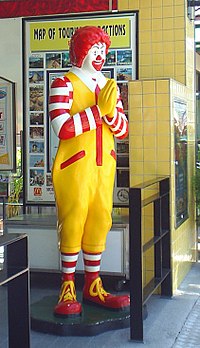Ronald McDonald
 Ronald McDonald
Ronald McDonaldRonald McDonald is a clown character used as the primary mascot of the McDonald's fast-food restaurant chain. In television commercials, the clown inhabited a fantasy world called McDonaldland and has adventures with his friends Mayor McCheese, the Hamburglar, Grimace, Birdie the Early Bird, and The Fry Kids. In recent years, McDonaldland has been largely phased out, and Ronald is instead shown interacting with normal children in their everyday lives.
Many people work full-time making appearances in the Ronald McDonald costume, visiting children in hospitals, and attending regular events. There are also Ronald McDonald Houses, where parents can stay overnight when visiting sick children in nearby chronic care facilities.
The origin of Ronald McDonald involves Willard Scott (at the time, a local radio personality who also played Bozo the Clown on WRC-TV in Washington, D.C. from 1959 until 1962), who performed using the moniker "Ronald McDonald, the Hamburger-Happy Clown" in 1963 on three separate television spots. These were the first three television ads featuring the character.
Scott, who went on to become NBC-TV's Today Show weatherman, claims to have "created Ronald McDonald" according to the following excerpt from his book Joy of Living:
At the time, Scott was working for Oscar Goldstein and John Gibson, Washington DC area McDonald's franchisees, and numerous sources describe Scott's role as only playing the part of Ronald McDonald, while giving credit for the creation of the mascot to Goldstein, Gibson, and their ad agency.
McDonald's does not mention George Voorhis or acknowledge that Willard Scott created Ronald in their statement:
"The smile known around the world," Ronald McDonald is second only to Santa Claus in terms of recognition. (According to one survey, 96% of all schoolchildren in the United States of America recognize Ronald (stunning-stuff.com)). In his first television appearance in 1963, the clown was portrayed by Willard Scott.
...
Wikipedia